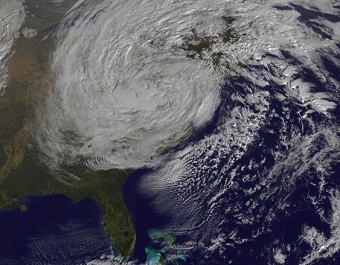How Does Climate Change Make Superstorms Like Sandy More Destructive?
 Climate science explains how global warming can make a superstorms like Sandy more destructive in several ways:
Climate science explains how global warming can make a superstorms like Sandy more destructive in several ways:1.Warming-driven sea level rise makes storm surges more destructive. In fact, a recent study found “The sea level on a stretch of the US Atlantic coast that features the cities of New York, Norfolk and Boston is rising up to four times faster than the global average.”
2.”Owing to higher SSTs from human activities, the increased water vapor in the atmosphere leads to 5 to 10% more rainfall and increases the risk of flooding,” as Kevin Trenberth explained to me in a 2011 email about Hurricane Irene. He elaborates on that point for Sandy here and for all superstorms in this article.
3.”However, because water vapor and higher ocean temperatures help fuel the storm, it is likely to be more intense and bigger as well,” Trenberth added. Relatedly, warming also extends the range of warm SSTs, which can help sustain the strength of a hurricane as it steers on a northerly track into cooler water (much as apparently happened for Irene). September had the second highest global ocean temperatures on record and the Eastern seaboard was 5°F warmer than average (with global warming responsible for about 1°F of that).
4.The unusual path of the storm — into the heavily populated east coast rather than out to see — was caused by a very strong blocking high pressure system that recent studies have linked to warming. Meteorologist and former Hurricane Hunter Jeff Masters has an excellent analysis of this, “Why did Hurricane Sandy take such an unusual track into New Jersey?”
I have put these in order from most scientific certainty to least. The first two — the impact of sea level rise and increased water vapor — are unequivocal. The third is extremely likely. The fourth is more speculative.
Remember, climate scientists and others have for quite some time been warning New York City that climate change was dramatically increasing the odds of a devastating storm surge — see Greg Laden’s post, “Peer Reviewed Research Predicted NYC Subway Flooding by #Sandy.” See also today’s NY Times story, “For Years, Warnings That It Could Happen Here.” Also a brand new study of storm surges since 1923 finds “that Katrina-magnitude events have been twice as frequent in warm years compared with cold years” — so more severe surges are on the way.
And that’s the other key reason we must make the connection to climate change: Scientists worst-case scenarios are already happening — so their latest findings deserve attention so that Sandy doesn’t become just another Cassandra whose warnings are ignored. Now climate scientists project that we risk up to 10 times as much warming this century as in the last 50 years — with many devastating consequences from dramatic sea level rise to Dust-Bowlification.
That means the 4 factors described above are going to have a greater and greater impact over time. That’s one of the many, many reasons we must act to reduce emissions ASAP, so we don’t keep getting “new normals” that ultimately make Sandy and Irene seem tame.
The media coverage of the link between Sandy and climate change started (too) slowly, as Climate Progress reported, but has vastly improved. NBC News in particular had a great story with Trenberth that touched on the points above.
Unfortunately, while more of the media are getting the story right, some are still not.
Some ask and answer the wrong question, as for instance, the Houston Chronicle story “Are hurricanes hitting New York in October a sure sign of global warming?” The loaded phrase here is “a sure sign of.” That story ends by dismissing the notion of “blaming Sandy on climate change” — another loaded phrase.
Climate Central gets the story right with its story, “HOW WARMING WORSENED SANDY’S IMPACTS: Global warming made Hurricane Sandy more destructive than it otherwise would have been, through sea level rise, warmer ocean temperatures, and other influences….”
I am generally a fan of linguist George Lakoff’s writing — and cite him at length in my latest book, Language Intelligence: Lessons on Persuasion from Jesus, Shakespeare, Lincoln and Lady Gaga. But I think he gets it wrong with his piece, “Global Warming Systemically Caused Hurricane Sandy.” He asserts “Smoking is a systemic cause of lung cancer. HIV is a systemic cause of AIDS.” Well, yes, but you can’t get AIDS without HIV. You can get hurricanes without global warming. A highly disproportionate and statistically significant number of people who smoke get lung cancer. Again, that simply isn’t analogous to the connection between global warming and Hurricane Sandy.
I can’t repost enough times Trenberth’s statement from his must-read paper “How To Relate Climate Extremes to Climate Change”:
The answer to the oft-asked question of whether an event is caused by climate change is that it is the wrong question. All weather events are affected by climate change because the environment in which they occur is warmer and moister than it used to be….
And as Climate Progress reported last week, Munich Re, a top reinsurer, released a major new study that for the first time, links the rapid rise in North American extreme weather catastrophes to manmade climate change:
“Climate-driven changes are already evident over the last few decades for severe thunderstorms, for heavy precipitation and flash flooding, for hurricane activity, and for heatwave, drought and wild-fire dynamics in parts of North America.”
You can return to the main Market News page, or press the Back button on your browser.

